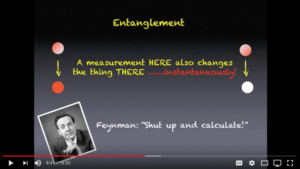After reading Chad Orzel’s article “How Do You Create Quantum Entanglement?” I discovered this 2011 TEDx 18′ video in which physicist Leo Kouwenhoven talks about what his lab at Delft University of Technology is actually building on the basis of spooky quantum superposition and entanglement.
“Spooky” physics – Leo Kouwenhoven ( TEDxDelft) – uploaded on Nov 28, 2011.
What Einstein called “spooky,” Physicist Leo Kouwenhoven calls the future. In this illuminating talk, he explains quantum entanglement — the property that shows how particles can affect each other, even if they’re on opposite ends of the universe — and demonstrates how we will manipulate it to revolutionize the way our computers work.
Leo Kouwenhoven is professor Quantum Transport. Quantum mechanics is the theory of atoms and elementary particles. Man itself is made out of atoms as well so quantum is the basis of our existence: life as we know it. Recent studies show that even large objects act quantum like existing in two places at the same time. Leo and his team can visualise this behaviour to the naked eye because these two places are now one centimeter away from each other. Imagine the possibilities (for mankind) when the distance increases. That’s a one centimeter step for man, one giant leap for mankind.
Here’s an excerpt from Kouwenhoven’s talk:
Luckily we also have other heroes in physics, and this is a theoretical physicist called Richard Feynman, and he said that’s you know let’s not be bothered with all these philosophical you know consequences of our theory — let’s calculate and see what happens.
Now here at the Delft University of Technology we educate engineers actually guys like me and our you know approach is that we feel challenged — that we say ok let’s do it. So what do we do we take these two particles. We bring them far apart and we bring make it a bit more complicated we bring in a third particle the green one. The green one we bring to the left one, and we make these two interact. I’m going to give them some interaction, but view the graph carefully — you see that at the same moment when these two interact and share some color, also the particle on the right which was still entangled with the first one also becomes green a little bit. Now next is that I ask for color hey left particles. I do a color measurement and they for instance turn white radish at the same time the one on the right becomes green.
So look what I’ve done effectively. let’s start again I’m bringing a green particle they in tango they’re also entangled with the one on the right and click once more and the one on the right is now green. I have teleported the green particle from the left universe to the right universe over a long distance instantaneously. So this teleportation is what we call let’s say absurd or strange or you know very odd, but we can do it and we actually do it and actually we do this in the lab. And we’ve actually done it so many times that we actually made it a student proof setup. I can tell you if it setup a student proof, then it’s you know it’s a very robust setup alright.
I wonder what’s new at his lab since the TEDx presentation.
We design and realize nano-scale objects with desirable quantum mechanical behavior. We are, for instance, controlling the motion of individual electrons, create quantum superpositions of single spins, transfer spin-states to flying photons, induce superconductivity into semiconductors and try to detect new particles (Majorana Fermions). For these goals we use one-dimensional materials such as carbon nanotubes and semiconductor nanowires. By means of nanofabrication we define nanoscale electronic and photonic devices with new quantum functionality. Those devices are measured at very low temperatures (close to absolute zero temperature). Our labs are high-tech in terms of nanofabrication, low-temperature setups and low-noise electronics. We hope that in the long term our fundamental studies will turn quantum mechanics into a new resource for technology.
Our latest device: An InSb nanowire connected to source and drain contacts and capacitively coupled to 5 narrow gate electrodes.



There was quite a range of comments on this lecture — “Spooky” physics by Leo Kouwenhoven (TEDxDelft). For example, some speculated on higher dimensions and holographic projection into our space-time. Here’re a few that I found interesting — grappling with the weirdness of quantum physics.
1.
2.
3.
Here’s a comment on another lecture, “Quantum Physics for 7 Year Olds” by Dominic Walliman (TEDxEastVan) – Youtube published on May 24, 2016.